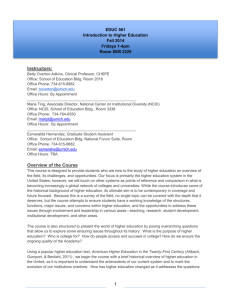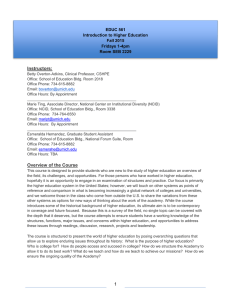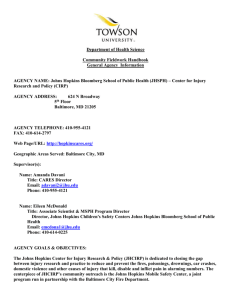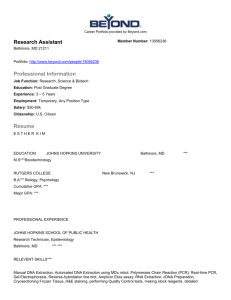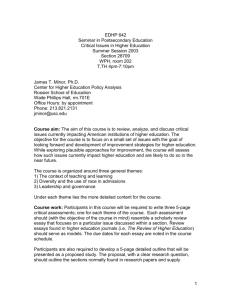EDL 579 Comps Summary
advertisement
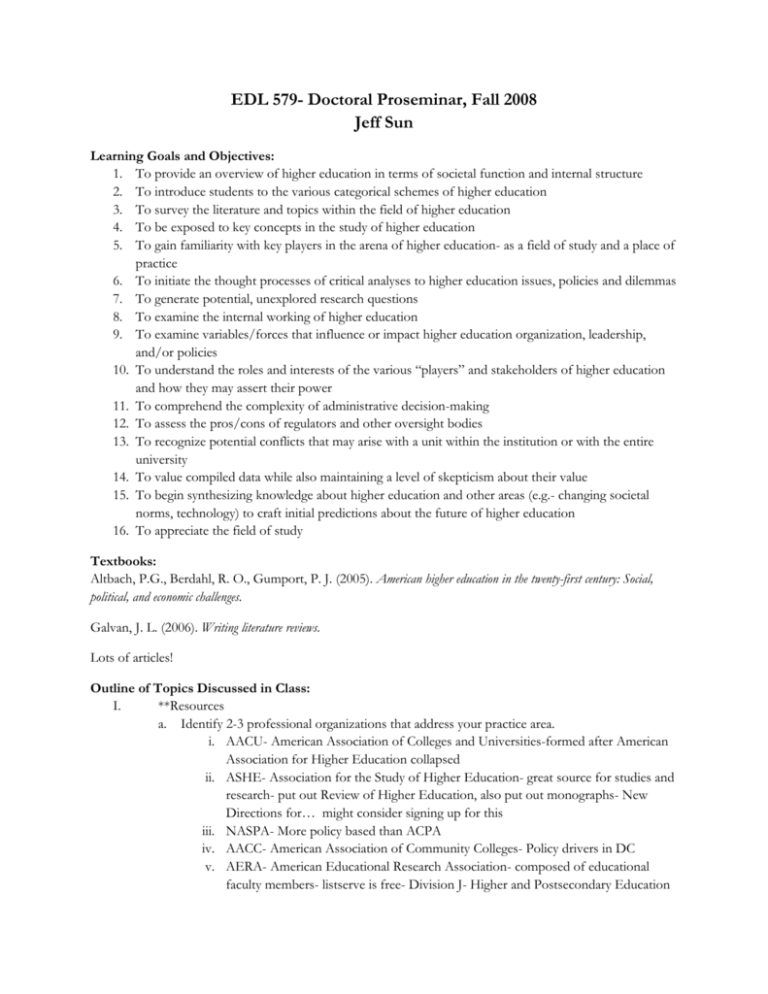
EDL 579- Doctoral Proseminar, Fall 2008 Jeff Sun Learning Goals and Objectives: 1. To provide an overview of higher education in terms of societal function and internal structure 2. To introduce students to the various categorical schemes of higher education 3. To survey the literature and topics within the field of higher education 4. To be exposed to key concepts in the study of higher education 5. To gain familiarity with key players in the arena of higher education- as a field of study and a place of practice 6. To initiate the thought processes of critical analyses to higher education issues, policies and dilemmas 7. To generate potential, unexplored research questions 8. To examine the internal working of higher education 9. To examine variables/forces that influence or impact higher education organization, leadership, and/or policies 10. To understand the roles and interests of the various “players” and stakeholders of higher education and how they may assert their power 11. To comprehend the complexity of administrative decision-making 12. To assess the pros/cons of regulators and other oversight bodies 13. To recognize potential conflicts that may arise with a unit within the institution or with the entire university 14. To value compiled data while also maintaining a level of skepticism about their value 15. To begin synthesizing knowledge about higher education and other areas (e.g.- changing societal norms, technology) to craft initial predictions about the future of higher education 16. To appreciate the field of study Textbooks: Altbach, P.G., Berdahl, R. O., Gumport, P. J. (2005). American higher education in the twenty-first century: Social, political, and economic challenges. Galvan, J. L. (2006). Writing literature reviews. Lots of articles! Outline of Topics Discussed in Class: I. **Resources a. Identify 2-3 professional organizations that address your practice area. i. AACU- American Association of Colleges and Universities-formed after American Association for Higher Education collapsed ii. ASHE- Association for the Study of Higher Education- great source for studies and research- put out Review of Higher Education, also put out monographs- New Directions for… might consider signing up for this iii. NASPA- More policy based than ACPA iv. AACC- American Association of Community Colleges- Policy drivers in DC v. AERA- American Educational Research Association- composed of educational faculty members- listserve is free- Division J- Higher and Postsecondary Education vi. NACADA- Academic Advising vii. NACDA, NACMA, AEMA, NATA- Athletics b. Identify 2-3 professional journals/magazines that inform you about new and emerging ideas in your practice area. c. Identify 3-4 academic journals that examine research matters about higher education as an area of study and its practice. i. Review of Higher Education ii. Journal of Higher Education iii. Research in Higher Education iv. Higher Education: The International Journal of Higher Education and Educational Planning II. Higher Education: An “Institution” & A Development for Practicing Professionals a. **Public Economic Benefits of Higher Ed (See Slides) i. Those who have higher levels of education contribute higher levels to the tax basebenefit, not a purpose ii. Increased consumption- Greater levels of productivity, more disposable income iii. Increased workforce flexibility- people think more critically iv. People don’t need as much government assistance b. Public Social Benefits of Higher Ed i. Fewer prisoners with college education ii. More likely to vote iii. More likely to be in civic and community groups c. Private Economic Benefits of Higher Ed i. People are focused much more on these ii. People make more than 1 million dollars more with a bachelor’s degree than without iii. Every year of college increases potential for income by 5-6% d. Private Social Benefits of Higher Ed III. Institutional Variations and Mission Statements a. **Carnegie Classifications i. Who are we most alike? ii. Data is self-reported iii. Might be too simplistic; doesn’t take into account differences within iv. Any time you do comparisons, you do them to your advantage v. Carnegie is perceived by some as a ranking system vi. Sometimes used as a motivator to get us to become something vii. Makes a difference for funding b. Taxonomies-( See your notes.) c. Minority Serving Institutions d. Historically Black Colleges and Universities e. Online Universities f. NCAA Divisions Institutional Variations, Mission Statements, and Rankings IV. a. Terms i. IPEDS- federally mandated programs ii. Classification of Instructional Programs- Every major or every area of study has a CIP Code iii. Full Time Equivalent- federal government has a definition, and states may have a different definition, and grad programs may have individual definition iv. There is a federal guideline for how to fill out the IPEDS v. Title IV- any federal financial aid vi. OPE- Office of Postsecondary Education- within the Department of Education vii. FIPS- Federal Information Processing GuidelineS b. **Factors That Influence Rankings i. Institutional size and scope ii. Mission iii. Mix of disciplines iv. Institutional control v. Medical schools vi. Health science programs vii. Agricultural Extension or Experiment Stations viii. Single campus, multiple/branch, system ix. Notes: 1. You can either align yourself with or distinguish yourself from data. 2. Where are your priorities? Sometimes have to give priority to people in your state. 3. If you don’t have many science disciplines, you will get less research dollars. 4. Who are you competing with in your system? 5. Ag extensions get a special allocation from the government x. Data reliability problems 1. Institutional accounting practices 2. Limitations on reporting ability 3. Variations in institutional interpretations of data definitions V. Contextual Matters of Higher Education a. Major Issues for Higher Ed in the 21st Century i. Privatization of Funding ii. Research Mission iii. Access iv. Ph.D. Job Market v. Accountability and Governance b. Friedrich-Finer Debate- I feel like we need to know this, but I don’t understand it myself. c. Spellings Report i. measuring and reporting college student outcomes ii. privacy-protected student-level data system iii. lack of adequate preparation for college iv. streamline federal financial aid VI. External Forces a. Federal Government i. 2 ways that the federal government can guide us 1. funding- if you take it, then you must comply 2. reporting standards ii. Money has shaped higher ed through: 1. Land Grants 2. GI Bill 3. Title IV iii. Federal government provides 50% of total research, 80% of this to 100 institutions b. State Governments c. Bologna Process- Again, we should understand this, but I don’t have good notes. i. If this catches on, this will catch on easier for those institutions that have already started ii. It is much easier to prove outcomes than “I think critically.” iii. Degrees are looked at as warranties. iv. European model to challenge American model 1. Ratcheting the curriculum 2. Having universal performance based outcomes at each level 3. Wanting same outcomes across institutions 4. Some people ECS would like a common course numbering system from one school to the other. 5. For profits are pushing for institutions to have courses mean the same thing. 6. Credits issued in student working hours vs. faculty contact hours d. Legal Environment VII. Context Shifts in Higher Education- Students a. This unit appears to have been an analysis of survey questions and what was good or bad about them. VIII. Context Shifts in Higher Education- Funding & Cost a. Sixth Sigma- Eliminate the outliers; you want everything to be within 6 standard deviations of the mean b. AQUIP-Baldridge- Academic Quality Improvement Project/Programs i. Degrees of Total Quality Management ii. Sets benchmarks and you see how you are comparing over time iii. Instead of 10 year portfolio, have to show continuous improvement iv. Some schools use a rebate program where they take back money from everyone and reward innovation c. State Government Funding- See Unit 8 Slides IX. Institutional Leadership a. Three current issues that keep college presidents up now: i. Finances ii. Security iii. Morale iv. Accountability b. Three issues that keep them up in 10 years: i. Finances ii. Work force iii. Move to online education iv. Transparency of decision making v. Mental Health Issues vi. Accreditation vii. Balance c. Presidents have gone through a cycle of roles. i. A lot more administrators today to do the work and operations on campus. ii. Greater development role d. **Accreditation is regionally based because higher ed is not federally based i. We are accredited by the North Central Association and the Higher Learning Commission within it 1. 6 regional associations out there ii. Open University- online school in UK- came to US to start school here. “I thought when I came here I was dealing with one country not 50.” e. Congress is trying to get schools to eat away their endowments. Cost cannot go up while endowments are so high. Assignments: -Division Report Additional Notes: See Reading Summaries §2.1.a American Council on Education (2001). A brief guide to U.S. higher education. Washington, D.C.: Author. http://www.acenet.edu/bookstore/pdf/2001_brief_guide.pdf Total, basic overview of American Higher Education System By 1999, 66% of population had some college education 4,064 institutions of higher education o 58% private o Public institutions enroll 79 percent of college students o Doctorate granting institutions make up 7 percent if institutions but enroll 27 percent of students o 42 percent of institutions are two year o Less than 25 percent of students are “traditional” 2 types of accreditation- institutional and specialized o 8 regional accrediting associations Major issues for higher education o Costs and funding o Quality and assessment o Access o Governance o Information technology o Internationalization Although more women than men are enrolled in college, they earn about half as many professional degrees Skim the data contained within The Condition of Education http://nces.ed.gov/programs/coe/ This website is an integrated collection of the indicators and analyses published in The Condition of Education 2000–2008. Some indicators may have been updated since they appeared in print. The rate of students entering college immediately after high school graduation increased from 49 percent in 1972 to 67 percent by 1997, but has since fluctuated between 62 and 69 percent. Since 1970, women’s undergraduate enrollment has increased over three times as fast as men’s. Currently, women make up 57 percent of undergraduate enrollment. Minority students have accounted for about half of the growth in associate’s and bachelor’s degrees awarded between 1989–90 and 2003–04. In 2006, young adults with a bachelor’s degree earned about $11,000 more than those with an associate’s degree, about $16,000 more than those who had completed high school, and more than twice as much than those who did not earn a high school diploma. In 2006–07, there were 1,045 community colleges in the United States, enrolling 6.2 million students (or 35 percent of all postsecondary students enrolled that year). Average annual community college tuition and fees are less than half those at public 4-year colleges and universities and one-tenth those at private 4-year colleges and universities. Community colleges enroll a diverse group of students, with various reasons for going to college, and have larger percentages of nontraditional, low-income, and minority students than 4-year colleges and universities. High school seniors who enrolled immediately in community colleges in 2004 spanned a broad range of academic achievement—including students who were well-prepared for college in terms of their performance on standardized tests and coursework completed. They included a greater percentage of well-prepared seniors than did the 1992 senior cohort. About two-thirds of 2004 seniors who enrolled immediately in a community college seem to have done so with the intention of pursuing a bachelor’s degree or higher: as high school seniors, 28 percent had planned to use a community college as a stepping stone to a bachelor’s degree and 39 percent revised their original plans to attend a 4-year college and earn a bachelor’s degree by starting their postsecondary education at a community college. One-third of 2004 seniors who enrolled immediately in a community college did so with no intention of pursuing any education higher than an associate’s degree; however, by 2006, almost 47 percent of this group had raised their educational expectations to start or complete a bachelor’s degree. The percentage of students who had left school by 2006 without completing a degree or certificate program was higher among 2003–04 community college freshmen who intended to transfer to a 4year college than among all 2003–04 freshmen at public 4-year and private not-for-profit 4-year institutions. §2.2.a Altbach, P. G. (2005). Patterns in higher education development. In P. G. Altbach, R. O. Berdahl, & P. J. Gumport, American higher education in the twenty-first century: Social, political, and economic challenges (pp. 15-37). Baltimore, MD: Johns Hopkins University Press. Looks at basic trends in higher education and patterns of development §2.2.b Geiger, R. (2005). The ten generations of American higher education. In P. G. Altbach, R. O. Berdahl, & P. J. Gumport, American higher education in the twenty-first century: Social, political, and economic challenges (pp. 38-70). Baltimore, MD: Johns Hopkins University Press. Reformation Beginnings (1636-1740s)- focused on pulling themselves away from the religion of England; very classic curriculum Colonial Colleges (1745-1775)-many students destined for ministry; professors became more qualified; colleges balanced duty to church and public Republican Education (1776-1800)-non-denominational schools started to form in the west; states started to make provisions for higher education Passing of Republican Education (1800-1820)- violence becomes more prevalent; students come to college more lax and less prepared; questions started to rise over who should control the collegespublic or private The Classical Denominational Colleges (1820-1850)- argument over purpose and function of curriculum; colleges have different focuses in different areas of the country New Departures (1850-1890)- Land Grant Act, formation of women’s colleges; shift of purpose for agriculture and work-based education; curriculum change to allow for specialization Growth and Standardization (1890-World War I)- expansion in enrollment v. formation of new institutions; more women in coed institutions; universities became departmentalized Hierarchical Differentiation Between the Wars- started to form elite, liberal arts based institutions, two year institutions, etc. Academic Revolution (1945-1975)- two movements prevailed- expansion and access for more and standardization; focus on space and science; stunt revolution and institutional permissiveness vs. paternalism Regulation, Relevance, and the Steady State-federal funding switches to individual student financial aid; students switch to more vocational degrees vs. arts and sciences §2.3.a [Print & Bring] Taub, D. J., & McEwen, M. K. (2006). Decision to enter the profession of student affairs. Journal of College Student Development, 47(2), pp. 206-216. §2.3.b [Print & Bring] Renn, K. A., & Jessup-Anger, E. R. (2008). Preparing new professionals: Lessons for graduate preparation programs from the National Study of New Professionals in Student Affairs. Journal of College Student Development, 49(4), pp. 319-335. §3.1.a [Skim] Lombardi, J. V., Craig, D. D., Capaldi, E. D., & Gater, D. S. (2002). University organization, governance, and competitiveness. Gainesville: TheCenter, University of Florida. Basics of institutional organization and governance at research institutions. §3.1.b [Skim] Morphew, C. C. (2002). “A rose by any other name”: Which colleges became universities. Review of Higher Education, 25(2), 207-223. Institutions that change their name from colleges to universities are more likely to do so based on selectivity (less-selective institutions are more likely to change their name than more selective ones) and change in mission (to serve graduate students). Funding issues did not seem to be a factor. §3.1.c Gleckner, R. F. (1998). A taxonomy of colleges and universities. In A. L. Deneef & C. D. Goodwin (Eds.), The academic’s handbook (pp. 3-16). Durham, NC: Duke University Press. Differentiation of opportunities for PhDs at small, medium and large instituions §3.2.a Review these websites http://www.carnegiefoundation.org/about/sub.asp?key=18&subkey=405 Basics of Carnegie classification- FAQ http://www.carnegiefoundation.org/classifications/index.asp?key=783 Definition of Carnegie classification websites §3.2.b [Skim] Shaffer, D. F. (2008). The states and their community colleges. Albany, NY: Education Policy Brief, The Nelson A. Rockefeller Institute of Government. Retrieved at http://www.rockinst.org/WorkArea/showcontent.aspx?id=14870 Differences in community colleges across the fifty states based on community colleges’ share of all higher education enrollments in a state, the share of the state’s total population age 18 and over that’s enrolled full or part-time in a community college, the share of a state’s total population 18 and over that’s represented by full-time equivalent registration in community colleges, the five-year growth rate in community college environment, and the amount by which growth in community college enrollments is outpacing (or lagging) the growth in public four-year college environments. §3.3.a Finn, Jr., C. E. (1998, Jan 9). Today’s academic market requires a new taxonomy of colleges. Chronicle of Higher Education, 44(18), B4-B5. Creates a more simple classification summary- elite, mass providing, and convenience institution. As enrollment numbers begin to decrease, more students will be drawn to elite institutions in order to have a competitive degree and convenience institutions because of the cost. Mass providing institutions will have to redefine themselves to remain successful. §3.4.a O'Brien, E. M., & Zudak, C. (1998). Minority-serving institutions: An overview. In J. P. Merisotis & C. T. O'Brien (Eds.). Minority serving institutions (New directions for higher education, No. 102) (pp. 5-15). San Francisco, CA: Jossey Bass Publishers. Information about the three types of minority serving institutions and their types. §4.1.b [Skim] Meacham, J. (2008, Jan/Feb.). What’s the use of a mission statement?. Academe Online. Retrieved at http://www.aaup.org/AAUP/pubsres/academe/2008/JF/Feat/meac.htm?PF=1 Talks about the commonalities of mission statements, the defense of academic freedom, impact on the curriculum and steps for revision. Very simple and easy to understand. §4.1.c [Skim] Hurtado, S. (2003). Institutional diversity in American higher education. In S. R. Komives, D. B. Woodward, Jr., & Associates (Eds.) (2003), Student services: A handbook for the profession (4th ed.) (pp. 23-44). San Francisco: Jossey-Bass. Summary of the diversity of higher education institutions within the US. §4.1.d Nidiffer, J., & Bouman, J. P. (2001). The chasm between rhetoric and reality: The fate of the “democratic ideal” when a public university becomes elite. Educational Policy, 15(3), 432-451. Examined how the University of Michigan, in becoming an elite institution abandoned its mission of serving the poor, and instead sought to study how and why they became poor. §4.2.a Gater, D. S. (2003). Using national data in university rankings and comparisons. Gainesville, FL: TheCenter. Retrieved at http://mup.asu.edu/gaternatldata.pdf Talks about the challenges of comparing data, in that not all are obtained the same way or for the same audience. §4.2.b [Skim] Ehrenberg, R. G. (2002). Reaching for the brass ring: The U.S. News & World Report rankings and competition. Review of Higher Education, 26(2), 145-162. Summary of how USNWR rankings are derived and what lengths some institutions will go to in order to change them. §4.2.c [Skim, pp. 23-34 only] Institute for Higher Education Policy (Ed.) (2007). College and university ranking systems: Global perspectives and American challenges (pp.23-34) Washington, D.C.: IHEP. Retrieved at http://www.ihep.org/assets/files/publications/a-f/CollegeRankingSystems.pdf Examines differences in global league tables in comparison rankings. Definitions of quality vary from table to table. Those institutions at the top, though, are almost always at the top. Differences come as you move down the table. §4.2.d [Optional] Carey, K. (2006). College ranking reformed: The case for a new order in higher education. Washington, DC: Education Sector. §5.1.a Zusman, A. (2005). Challenges facing higher education in the twenty-first century. In P. G. Altbach, R. O. Berdahl, & P. J. Gumport, American higher education in the twenty-first century: Social, political, and economic challenges (pp. 115-160). Baltimore, MD: Johns Hopkins University Press. Summary of challenges facing American Higher Education, including funding, research money, and accountability. §5.1.b [Optional] Benjamin, R. (2003). The environment of American higher education: A constellation of changes. Annals of the American Academy of Political and Social Science, 585, 8-30. §5.2.a O’Neil, R. M. (2005). Academic freedom: Past, present, and future beyond September 11. In P. G. Altbach, R. O. Berdahl, & P. J. Gumport, American higher education in the twenty-first century: Social, political, and economic challenges (pp. 91-114). Baltimore, MD: Johns Hopkins University Press. Looks at academic freedom and tenure. Gives history of academic freedom and examines how federal and state governments influence it and court cases debated about it. Looks at the impact of September 11th on academic freedom. §5.3.a Schmidtlein, F. A., & Berdahl, R. O. (2005). Autonomy and accountability: Who controls academe?. In P. G. Altbach, R. O. Berdahl, & P. J. Gumport, American higher education in the twenty-first century: Social, political, and economic challenges (pp. 71-90). Baltimore, MD: Johns Hopkins University Press. Looks at the influence of state and federal government on higher education. Looks at learning outcomes, budgeting and accreditation as means of accountability. §5.3.b Dunn, D. D. (2003). Accountability, democratic theory, and higher education. Educational Policy, 17(1), 60-79. Article discusses the balance of internal controls (responsibility) and external controls (accountability by elected officials) posited by Fiedler and Finer in democratic theory and concludes that faculty and administration must be willing to work with elected officials in order to be most successful. §6.1.a Gladieux, L. E., King, J. E., & Corrigan, M. E. (2005). The federal government and higher education. In P. G. Altbach, R. O. Berdahl, & P. J. Gumport, American higher education in the twenty-first century: Social, political, and economic challenges (pp. 163-197). Baltimore, MD: Johns Hopkins University Press. Talks about the role of the federal government in higher education in the areas of research, financial aid and regulations. §6.1.b McGuiness, Jr., A. C. (2005). The states and higher education. In P. G. Altbach, R. O. Berdahl, & P. J. Gumport, American higher education in the twenty-first century: Social, political, and economic challenges (pp. 198-225). Baltimore, MD: Johns Hopkins University Press. Talks about state oversight of higher education and the things that impact change in this area. §6.2.a Harcleroad, F. F. (2005). The hidden hand: External constituencies and their impact. In P. G. Altbach, R. O. Berdahl, & P. J. Gumport, American higher education in the twenty-first century: Social, political, and economic challenges (pp. 253-283). Baltimore, MD: Johns Hopkins University Press. §6.2.b Adelman, C. (2008). Learning accountability from Bologna: A higher education policy primer. Institute for Higher Education Policy (IHEP): Washington, D.C. §6.3.a Olivas, M. A. (2005). The legal environment: The implementation of legal change on campus. In P. G. Altbach, R. O. Berdahl, & P. J. Gumport, American higher education in the twenty-first century: Social, political, and economic challenges (pp. 226-252). Baltimore, MD: Johns Hopkins University Press. §7.1.a Dey, E. L., & Hurtado, S. (2005). College students in changing contexts. In P. G. Altbach, R. O. Berdahl, & P. J. Gumport, American higher education in the twenty-first century: Social, political, and economic challenges (pp. 315-339). Baltimore, MD: Johns Hopkins University Press. Talks about the student piece of the college environment from different perspectives. o Ecological- students influence their environment, and it influences them. o Traditional- students are a product of their background and characteristics. o Demographics on college campuses are changing at a faster rate than the environment to support them. o o Students are influenced by college but also by the larger social and political forces around them. Students are more prepared than past generations but are requesting more services for assistance. §7.2.a Review websites: Ÿ College Student Experience Questionnaire (CSEQ): http://www.indiana.edu/~cseq/ Ÿ Cooperative Institutional Research Program (CIRP): http://www.gseis.ucla.edu/heri/cirp.html Ÿ College Student Surveys (CSS): http://www.act.org/ess/fouryear.html Ÿ College Outcomes Survey (COS): http://www.act.org/ess/pdf/CollegeOutcomes.pdf Ÿ Noel-Levitz, Student Satisfaction Survey https://www.noellevitz.com/Our+Services/Retention/Tools/Student+Satisfaction+Inventory/Samples.htm §7.3.a [Optional] Bastedo, M. N. (2005). Curriculum in higher education: The historical roots of contemporary issues. In P. G. Altbach, R. O. Berdahl, & P. J. Gumport, American higher education in the twenty-first century: Social, political, and economic challenges (pp. 462-485). Baltimore, MD: Johns Hopkins University Press. §7.4.a Ashburn, E. (2008). Student pool is expected to dip and diversify. Chronicle of Higher Education, 54(29), A1, A24-A25. The number of high school graduates is declining, but the number of minority graduates is sharply increasing. States with significant minority populations will continue to see growth §7.4.b Chang, M. J., Altbach, P. G., & Lomotey, K. (2005). Race in higher education: Making meaning of an elusive moving target. In P. G. Altbach, R. O. Berdahl, & P. J. Gumport, American higher education in the twenty-first century: Social, political, and economic challenges (pp. 517-556). Baltimore, MD: Johns Hopkins University Press. Discusses the implications of the changing racial demographics on campuses. o Fewer minorities are attending research I institutions, which send more students on to graduate school. o Minority enrollment has plateaud while the percentage of the overall population continues to increase. §8.1.a Skim report: Ÿhttp://www.collegeboard.com/prod_downloads/about/news_info/trends/trends_pricing_07.pdf [1] Compares pricing at public and private institutions. Also looks at increases and percentage of overall student budget. §8.1.b Johnstone, D. B. (2005). Financing higher education: Who should pay?. In P. G. Altbach, R. O. Berdahl, & P. J. Gumport, American higher education in the twenty-first century: Social, political, and economic challenges (pp. 369-392). Baltimore, MD: Johns Hopkins University Press. Examines the relationship between funding and higher education in the areas of quality, access, and efficiency. Also looks at size, efficiency and support needed §8.2.a Nicklin, J. L. (1995). The hum of corporate buzzwords: Colleges look to businesses for advice on restructuring. Chronicle of Higher Education, 41(20), A33-A34. Talks about the influence of corporate success measures in higher education. Discusses that some colleges are jumping on the business bandwagon, but not all are meeting with success. §8.2.b Van Der Werf, M. (1999, Sept. 3). A vice-president from the business world brings a new bottom line to Penn. Chronicle of Higher Education, 46(2), A72-A75. Talks about the transformation of the University of Pennsylvania who hired a VP from the corporate world. By looking at things from a business perspective, he is alienating staff but making an economic and efficiency difference in the University. §9.1.a Birnbaum, R., & Eckel, P. D. (2005). The dilemma of presidential leadership. In P. G. Altbach, R. O. Berdahl, & P. J. Gumport, American higher education in the twenty-first century: Social, political, and economic challenges (pp. 340-365). Baltimore, MD: Johns Hopkins University Press. Discusses the challenge of the University Presidency. Talks about the balance of responsibility and power and the various constituents the President must respond to. Presidents become middle managers often in state systems. There are not distinct measures of effectiveness for college presidents. Understanding institutional culture is critical to the success of a president in gaining followers. Presidents often have a high sense of self-confidence. §9.1.b Media General News Service (2008, Aug. 18). College leaders find themselves on hot seat. Virginia Daily Progress. Discusses the high burnout and turnover of college presidents from the significant different demands on them and the challenge of meeting expect

